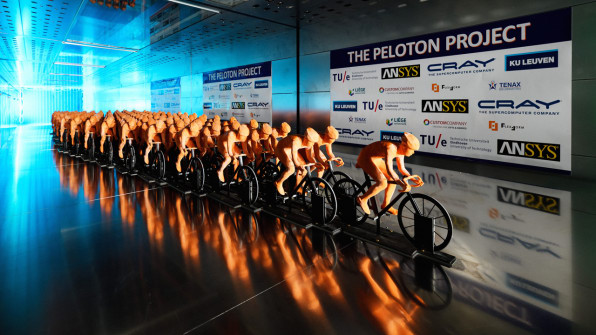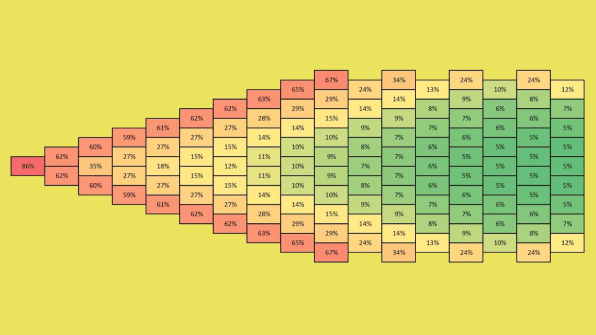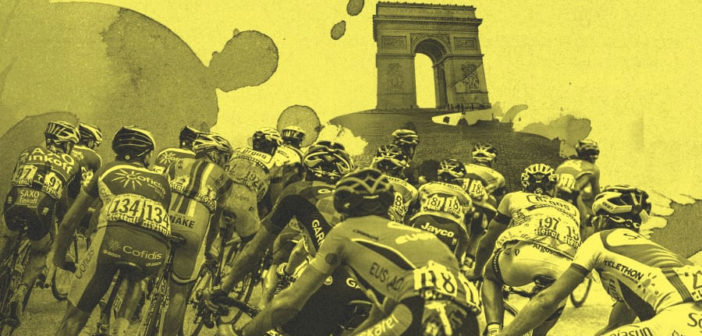New research about the physics of bike racing could change the sport.
To the average spectator, the physics of the Tour de France peloton–the group of hundreds of riders, packed together like sardines on the road–seems strange at best, and dangerous at worst. Sure, there’s some advantage to drafting off of your competitors or teammates, but an errant turn can wipe out half the group like dominos.
Now, researchers studying the aerodynamics of bike racing are shedding new light on the world’s most important bike race. Their new study, from the Eindhoven University of Technology & KU Leuven, confirms that the risk of the peloton is worth the reward–while offering hard numbers for the first time that could change the way we see cycling teams strategize in the future.
While previous studies have analyzed the wind resistance of a single or a few riders, the Eindhoven researchers placed 121 quarter-scale bicyclist models into a wind tunnel. They look something like a platoon of Terracotta Warriors on wheels. The bodies were shaped from the 3D scan of bike racers and molded out of Neolith, the same granite and glass composite used in many kitchens and flooring.

Using this physical model, lead author Bert Blocken–a former amateur cyclist for 15 years himself–was able to track actual wind resistance on each position with a new, unparalleled level of fidelity, to create a peloton wind resistance map. While he’d simulated the data on the computer in the past, the wind tunnel offered the opportunity to verify the simulations.“I was worried that part of the outside world would not believe the results. Therefore, I set up this wind tunnel experiment,” he says. With both studies confirming the same information, he calls his team “200% sure our results [are]accurate and reliable.”
So just what did he find? The wind resistance saved by pedaling in the middle of the peloton, rather than in the front, is far greater than previously thought. In the center rear of the pack, a cyclist has just 6% of the wind resistance that they would have riding on their own. Practically speaking, the energy savings is the equivalent of pedaling 9.3 miles per hour while actually flying down the road at 33.5 miles per hour.

Meanwhile, the point person of the peloton takes most wind resistance, but anyone on the outer edges still takes a high wind load. Blocken says it’s high enough to prove that key riders–say, your GC contender or your top sprinter–shouldn’t be riding in those positions whatsoever in a race. It’s just bad strategy that burns unneeded energy. Instead, the optimal spot is in rows six, seven, or eight. Positioned there, the rider gets substantial benefits of drafting, but they’re also able to avoid many crashes that happen toward the middle and back of the pack. Of course, such research only takes so many factors into account. It assumed a flat stage–which is a rarity throughout most of the tour–and doesn’t factor in things like corners, crosswinds, and other issues.
Still, Blocken expects the racing community will make quick use of this new data when altering racing strategy. “There are teams that are very good in absorbing and adopting scientific research and getting most out of it, such as Team Sky, Team BMC, Team LottoNL-Jumbo, and Team Groupama-FDJ,” he says. “These are teams at the forefront of innovation, with excellent embedded scientists in the team.”
That’s not a comment Blocken makes casually. He’s actually observed his own impact on the sport in the past few years.
“After Chris Froome descended the Peyresourde sitting on the top tube in a rather weird position and won stage eight [in 2016], many claimed this position had to be aerodynamically superior. We investigated it, and found that this is not true,” Blocken recounts. “We got a lot (A LOT!) of criticism at that time, but if you see Chris Froome descending now, like in the Giro 2018, he has changed his descent position to the one that we recommended as being the best from our research. It is nice to get extra confirmation this way. But this also shows that the real top teams are reading what you and me are writing in magazines and social media.”
–
This article first appeared in www.fastcompany.com
Seeking to build and grow your brand using the force of consumer insight, strategic foresight, creative disruption and technology prowess? Talk to us at +9714 3867728 or mail: info@groupisd.com or visit www.groupisd.com

